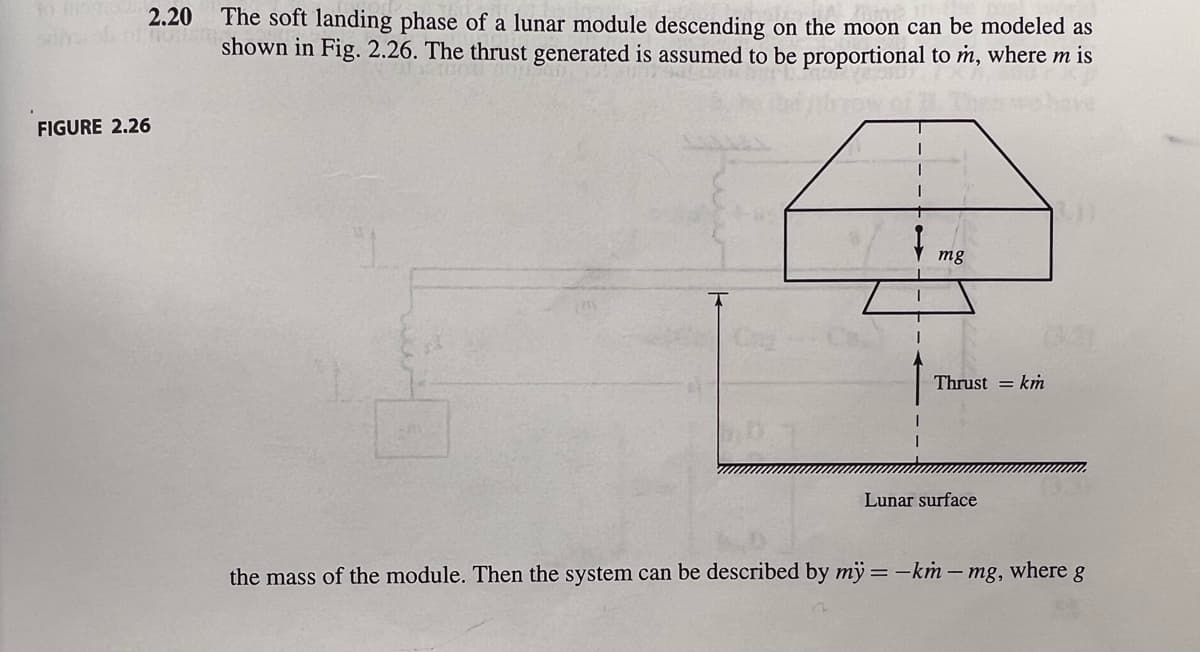2.20 The soft landing phase of a lunar module descending on the moon can be modeled as shown in Fig. 2.26. The thrust generated is assumed to be proportional to m, where m is HOUS 1.26 f mg Thrust = km Lunar surface 02 the mass of the module. Then the system can be described by my=-km-mg, where g
2.20 The soft landing phase of a lunar module descending on the moon can be modeled as shown in Fig. 2.26. The thrust generated is assumed to be proportional to m, where m is HOUS 1.26 f mg Thrust = km Lunar surface 02 the mass of the module. Then the system can be described by my=-km-mg, where g
Introductory Circuit Analysis (13th Edition)
13th Edition
ISBN:9780133923605
Author:Robert L. Boylestad
Publisher:Robert L. Boylestad
Chapter1: Introduction
Section: Chapter Questions
Problem 1P: Visit your local library (at school or home) and describe the extent to which it provides literature...
Related questions
Question

Transcribed Image Text:The soft landing phase of a lunar module descending on the moon can be modeled as
sin off shown in Fig. 2.26. The thrust generated is assumed to be proportional to m, where m is
2.20
FIGURE 2.26
mg
Thrust = km
Lunar surface
the mass of the module. Then the system can be described by my = -km - mg, where g

Transcribed Image Text:2.21
is the gravity constant on the lunar surface. Define state variables of the system as x₁ = y,
x2 = y, x3 = m, and u = m. Find a state-space equation to describe the system.
Find the transfer functions from u to y₁ and from y₁ to y of the hydraulic tank system
shown in Fig. 2.27. Does the transfer function from u to y equal the product of the two
transfer functions? Is this also true for the system shown in Fig. 2.16? [Answer: No,
Expert Solution
This question has been solved!
Explore an expertly crafted, step-by-step solution for a thorough understanding of key concepts.
This is a popular solution!
Trending now
This is a popular solution!
Step by step
Solved in 3 steps

Recommended textbooks for you

Introductory Circuit Analysis (13th Edition)
Electrical Engineering
ISBN:
9780133923605
Author:
Robert L. Boylestad
Publisher:
PEARSON

Delmar's Standard Textbook Of Electricity
Electrical Engineering
ISBN:
9781337900348
Author:
Stephen L. Herman
Publisher:
Cengage Learning

Programmable Logic Controllers
Electrical Engineering
ISBN:
9780073373843
Author:
Frank D. Petruzella
Publisher:
McGraw-Hill Education

Introductory Circuit Analysis (13th Edition)
Electrical Engineering
ISBN:
9780133923605
Author:
Robert L. Boylestad
Publisher:
PEARSON

Delmar's Standard Textbook Of Electricity
Electrical Engineering
ISBN:
9781337900348
Author:
Stephen L. Herman
Publisher:
Cengage Learning

Programmable Logic Controllers
Electrical Engineering
ISBN:
9780073373843
Author:
Frank D. Petruzella
Publisher:
McGraw-Hill Education

Fundamentals of Electric Circuits
Electrical Engineering
ISBN:
9780078028229
Author:
Charles K Alexander, Matthew Sadiku
Publisher:
McGraw-Hill Education

Electric Circuits. (11th Edition)
Electrical Engineering
ISBN:
9780134746968
Author:
James W. Nilsson, Susan Riedel
Publisher:
PEARSON

Engineering Electromagnetics
Electrical Engineering
ISBN:
9780078028151
Author:
Hayt, William H. (william Hart), Jr, BUCK, John A.
Publisher:
Mcgraw-hill Education,